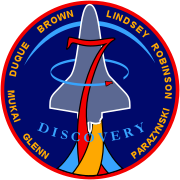STS-95

STS-95 launches from Kennedy Space Center, 29 October 1998
|
|
| Mission type | Bioscience research Astronomy |
|---|---|
| Operator | NASA |
| COSPAR ID | 1998-064A |
| SATCAT no. | 25519 |
| Mission duration | 8 days, 21 hours, 44 minutes, 2 seconds |
| Distance travelled | 5,800,000 kilometres (3,600,000 mi) |
| Spacecraft properties | |
| Spacecraft | Space Shuttle Discovery |
| Landing mass | 103,322 kilograms (227,786 lb) |
| Payload mass | 11,130 kilograms (24,540 lb) |
| Crew | |
| Crew size | 7 |
| Members |
Curtis L. Brown, Jr. Steven W. Lindsey Pedro Duque Scott E. Parazynski Stephen K. Robinson Chiaki Mukai John H. Glenn, Jr. |
| Start of mission | |
| Launch date | 29 October 1998, 19:19:34 UTC |
| Launch site | Kennedy LC-39B |
| End of mission | |
| Landing date | 7 November 1998, 17:04 UTC |
| Landing site | Kennedy SLF Runway 33. |
| Orbital parameters | |
| Reference system | Geocentric |
| Regime | Low Earth |
| Perigee | 550 kilometres (340 mi) |
| Apogee | 561 kilometres (349 mi) |
| Inclination | 28.45 degrees |
| Period | 96 min |
 Top: Parazynski, Robinson, Mukai, Duque, Glenn; Bottom: Lindsey, Brown |
|
STS-95 was a Space Shuttle mission launched from Kennedy Space Center, Florida on 29 October 1998, using the orbiter Discovery. It was the 25th flight of Discovery and the 92nd mission flown since the start of the Space Shuttle program in April 1981. It was a highly publicized mission due to former Project Mercury astronaut and United States Senator John H. Glenn, Jr.'s return to space for his second space flight. At age 77, Glenn became the oldest person, to date, to go into space. This mission is also noted for inaugurating ATSC HDTV broadcasting in the U.S., with live coast-to-coast coverage of the launch. In another first, Spain's Pedro Duque became the first Spaniard in space.
The mission's objectives involved investigating life-sciences experiments, using the SpaceHab module to perform these experiments on Senator Glenn. Scientific objectives on this mission were not limited to furthering an understanding of the human body, but also to increase astronomical understanding with regards to the Sun, and how it affects life on Earth. The Spartan 201 spacecraft was released by the crew, flying free from the Shuttle, studying the acceleration of the solar wind that originates in the sun's solar corona. The mission lasted just under nine days, with Discovery completing its voyage by landing at the Kennedy Space Center's Shuttle Landing Facility.
...
Wikipedia

